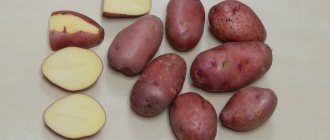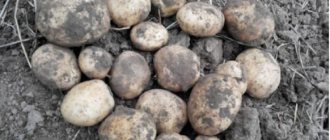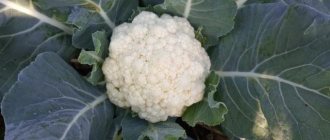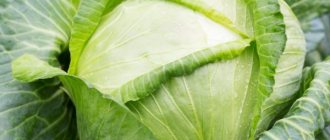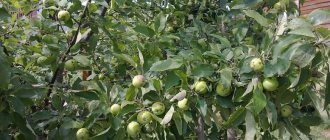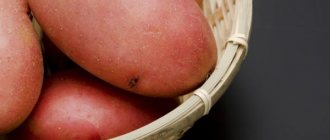Vegetable growing » Cabbage
0
1404
Article rating
Kira Stoletova
Snow White cabbage is a late-ripening medicinal vegetable crop. When stored, it does not lose its presentation for a long time. The transportability of the variety is high.
Characteristics of the Snow White cabbage variety
History of variety development
The Snow White cabbage variety is of Ukrainian origin, as it is the achievement of breeders of the Ukrainian Research Institute of Vegetable and Melon Growing. The new plant was obtained through free group pollination of the varieties Amager 611, Zimovka 1474, Denish Ballhead, Zimnyaya Gribovskaya 2176, Dauerweiss and some others, after which the most successful result was selected.
Initially, the variety was recommended for cultivation only in Ukraine and Kazakhstan, but today it is successfully grown in the central and southern regions of the Russian Federation.
Did you know? The word “cabbage” is associated with the ancient Greek and Roman concept “kaputum”, which means “head”. It is likely that the vegetable received its name precisely because of its external resemblance to this part of the human body.
Description and characteristics
At first glance, Snow White cabbage is similar to many other varieties of this crop, but for those who have already grown it, the differences are more than obvious. Not only the appearance, but also the taste of this vegetable deserves the attention of every gardener.
Heads of late-ripening varieties are the most productive and retain beneficial properties for many months
Description of cabbage heads
Heads of cabbage of late-ripening varieties are always the most productive, so it is not surprising that Snow White always pleases with the size of its heads. All of them consist of large leaves, 80–160 cm in diameter and are colored pale green. The edges of the lyre-shaped leaf blades are smooth, which distinguishes the variety from many others.
The surface of the heads of cabbage is dense and shiny (with a waxy coating), and the small stalk located outside has a round shape. The weight of one such large fruit ranges from 3–5 kg, and upon cross-section the white flesh becomes noticeable.
The rosette of the Snow White cabbage variety is medium-sized, transitional, with slightly raised or slightly drooping lower leaves. The fruits of this variety have increased resistance to cracking, but their main advantage is their high dry matter content: with a flat-round shape and average density of heads of cabbage, their content is 8.4–11.3%. The amount of sugars in this case is 4.1–6.0%, and ascorbic acid is about 32–41 mg.
Ripening time
The fruits of the described cabbage are ready for mass harvesting already in early September, however, this is only if the seeds were sown for seedlings in March or April. That is, from the appearance of the first shoots to the collection of the heads, an average of 127–150 days pass.
Most often, the fruits are consumed fresh, for pickling or winter storage.
Frost resistance of the variety
Snow White is a frost-resistant variety of cabbage, so even if you do not have time to harvest from the beds before the first frost, the heads will not lose their quality characteristics. When it drops to -5...-10°C, the crop will not be affected, however, it is better to avoid more significant frosts.
Important! For the active growth of young plants, organic compounds in the form of chicken droppings or manure are suitable, although solutions of urea and ammonium nitrate are no less relevant. However, in order to form a dense head of cabbage, it is advisable to continue fertilizing the plant with nitrogen-free compounds in the form of nitrophoska or wood ash.
Average yield
The marketable yield of the Snow White variety is 4.7–7.5 kg per 1 m², but this is not the limit. Often these figures increase to 10 kg per square meter, especially if the gardener did not forget to timely feed the cabbage with organic and mineral fertilizers.
Video: Snow White cabbage
Characteristics of Ankoma cabbage
Ancoma F1 (Ancoma RZ F1) is the company's leading product in the white cabbage sector. It is characterized by a marketable appearance, good shelf life and transportability. It tolerates unfavorable weather conditions, including drought, and shows stable yields. Resistant to Fusarium wilt and other fungal diseases.
Basic characteristics of the variety:
- leaf rosette: vertical or raised;
- head: round, dense, with thin leaves;
- leaves: medium size, round, slightly wavy along the edges, with a waxy coating of medium intensity;
- outer stalk: medium size;
- weight: 2.5–4 kg;
- texture: dense, crispy;
- tolerance: resistant to fusarium;
- ripening period: 120–130 days;
- taste qualities: high;
- yield: 100–120 t/ha.
Did you know? In China cabbage
—symbol of wealth: both words are pronounced the same
-
“tsai”.
Maybe it was this fact that added the meaning of “money” to the word “cabbage” in Russian. The described cabbage can be grown in household plots and in large farms, showing a yield of up to 120 t/ha. It is recommended to plant it in seedlings, but it can also be sown with seeds in open ground or a greenhouse.
Productivity and fruiting
The yield of the variety, confirmed in the State Register file, is 418–610 c/ha. The maximum yield obtained in the Smolensk region during variety trials was 714 c/ha. This indicator is influenced by soil fertility and the number of sunny days during the growing season.
Application area
Early and middle varieties, as well as all hybrids, are intended for consumption fresh, stewed, boiled: in salads, soups, main courses, pies. Thanks to their nutritional properties and benefits, cabbage products are present in our diet almost all year round.
Learn about growing other cabbage varieties:
Resistance to diseases and pests
Differences in resistance between varieties are observed in the field for both foliage and root systems. During variety testing, only those diseases are isolated to which resistance has been shown in all fields. In the Ankoma F1 variety this is fusarium wilt. The variety also shows moderate resistance to other fungal diseases.
Advantages and disadvantages of the variety
- Advantages of the variety:
- high and constant yield;
- excellent taste;
- resistance to adverse weather conditions (including frost resistance);
- possibility of storage until spring without loss of taste;
- excellent presentation of heads of cabbage that does not deteriorate during transportation;
- resistance to fungal diseases;
- ease of care.
No disadvantages of the variety have been identified. Features include the fact that in the Central regions of Russia it is desirable to grow mid-late cabbage using seedlings.
Advantages and possible disadvantages
Like any other variety, Snow White cabbage has both positive and negative reviews from gardeners, which only confirms the difference in its characteristics.
- The advantages of the plant can be considered:
- good seed germination;
- quite large and juicy heads (in the latter case, much depends on a sufficient amount of moisture);
- versatility of purpose (the harvested crop can be kept fresh, or you can prepare sauerkraut or pickled cabbage for the winter);
- crack resistance;
- high transportability and excellent shelf life of the heads (can be stored for up to six and sometimes eight months).
As for the disadvantages of the variety, the main ones will be average resistance to diseases and pests and late ripening , however, some gardeners, on the contrary, consider this feature an advantage (it guarantees the possibility of long-term winter storage of cut heads).
Also find out what to do if the cabbage does not set into a head.
Top 9 best varieties of cabbage for pickling
Adding an article to a new collection
Not all cabbage is suitable for pickling for the winter. To ensure that sauerkraut does not disappoint you, choose heads of suitable varieties and hybrids.
There is rarely a family that doesn’t like sauerkraut. This is perhaps the main vegetable side dish in the winter, when you can’t go out into the garden and pick fresh vegetables for a salad from the garden.
How tasty sauerkraut will be, of course, depends not only on a successful recipe, but also on a well-chosen variety that is suitable for this type of culinary processing.
We offer you a list of 9 proven varieties and hybrids that are suitable for pickling.
Snow White
Snow White is a popular late-ripening variety of white cabbage. Its heads of cabbage are juicy, strong, and are perfect for pickling, processing, and long-term storage in winter.
Another advantage of Snow White cabbage is its resistance to Fusarium wilt and vascular bacteriosis.
Productivity (kg per 1 sq.m.) Head weight (kg) Ripening (days) Storage
10-15 2.5-3.9 145-160 Long-term
Grandslam F1
Grandslam F1 is a cabbage hybrid that will delight you with a high yield. Heads of cabbage have large soft leaves that are well suited for pickling. After processing, this cabbage is sweetish and pleasant to the taste.
The hybrid is quite unpretentious and does not crack in the garden.
Productivity (kg per 1 sq.m.) Head weight (kg) Ripening (days) Storage
15-20 3-5 145-160 Short
Geneva F1
Another excellent cabbage hybrid for pickling for the winter is Geneva F1. The shape of the head of cabbage is almost perfectly round – a sight for sore eyes!
This cabbage is versatile: it can be stored for up to 8-9 months and is good in salads. In addition, it does not crack.
Productivity (kg per 1 sq.m.) Head weight (kg) Ripening (days) Storage
12-18 3-4 130-140 Long
Stone Head
Stone Head is a cabbage variety that will satisfy the needs of the most demanding summer residents. This cabbage is good fresh and can be stored for a long time. In addition, the heads of cabbage are quite hard, so they do not crack, contain a lot of sugars, and are suitable for pickling.
Productivity (kg per 1 sq.m.) Head weight (kg) Ripening (days) Storage
15-20 3.5-4 140-160 Long-term
Mara is a late-ripening variety of Belarusian selection. This cabbage boasts large heads, very long storage (until mid-spring), and resistance to cracking. It is also resistant to the accumulation of nitrates and radionuclides and rarely gets sick.
The sauerkraut from Mary's heads turns out excellent!
Productivity (kg per 1 sq.m.) Head weight (kg) Ripening (days) Storage
14-18 2.8-3.6 150-165 Long-term
Present
This variety of cabbage is truly a gift for vegetable growers! It is unpretentious, grows on almost any soil, and does not crack. Moreover, it is suitable for both fresh salads and stewing, pickling and pickling.
Cabbage Gift stores well and is easily transported.
Productivity (kg per 1 sq.m.) Head weight (kg) Ripening (days) Storage
12-22 2.5-4.5 115-135 Average
Polar
Cabbage Polar of Czech selection is notable for its high yield, resistance to cracking and sudden drops in temperature.
This cabbage can be stored for a long time and is very tasty when fermented.
Productivity (kg per 1 sq.m.) Head weight (kg) Ripening (days) Storage
12-15 3-4 140-150 Long
Glory
Slava is considered a medium-late ripening cabbage variety - 125 days pass from germination to harvest. This cabbage will give you large round heads of cabbage that can be used for preparing all kinds of dishes and pickling for the winter.
The harvested crop can be stored all winter, but only if you make sure that the cabbage does not rot due to high humidity.
Productivity (kg per 1 sq.m.) Head weight (kg) Ripening (days) Storage
12-20 3-5 125 Long-term
Growing seedlings
Cultivation of Snow White cabbage always begins with sowing seeds for seedlings , and this process consists of several important components: selecting the optimal timing for completing the procedure, selecting and properly preparing a site for planting grown seedlings and pre-sowing treatment of the seeds themselves.
Timing (sowing seedlings)
Seeds of late Snow White cabbage are sown in seedling boxes at the end of February or beginning of March, so that after two months the grown seedlings can be transplanted into the garden bed. The latest date for performing the sowing procedure in the middle zone is considered to be mid-March, since the heads planted later will not have time to ripen by the time of harvesting.
When growing cabbage, it is important to follow the rules
Soil selection and preparation
Cabbage seeds can be grown in groups, for which absolutely any seedling containers - small pots or boxes - are suitable. It is more convenient to transplant seedlings from individual containers or peat pots, but if they are not available, then you can get by with simple wooden containers filled with a light and nutritious substrate, which it is advisable to heat in the oven before use.
Did you know? People have been growing cabbage on the territory of modern Russia since ancient times, about which there are corresponding entries in the oldest reference book of Kievan Rus called “Svyatoslav’s Collection”. The document described cabbage heads as an everyday, familiar food product.
The optimal soil mixture for Snow White cabbage should consist of one part turf soil, one part humus and a small amount of wood ash (1 tablespoon of sifted substance will be enough for 1 liter of soil mixture). Soil disinfection can be carried out using elevated temperatures (calcination in the oven for 10–20 minutes) or by spilling the soil with a weak solution of potassium permanganate.
Pre-planting seed treatment
When purchasing Snow White cabbage seeds, be sure to pay attention to the expiration date of the selected product and the external characteristics of the packaging: there should be no signs of wetting, sunburn or other signs of improper storage. Expired or damaged seeds will not guarantee high germination and the expected result of growing cabbage.
Pre-planting treatment of seed material is necessary for rapid germination and the appearance of only strong and healthy seedlings, without the slightest signs of disease or pest damage.
Read more about how to properly plant and grow cabbage.
The main stages of work in this case will be the following:
- soaking seeds in warm water;
- selection of settled specimens and removal of floating specimens;
- warming and disinfection of suitable seed material.
Warming up cabbage seeds is done by dipping them in hot water (temperature +50...+55°C) for 2-3 minutes, which will be enough to remove germs, bacteria and other possible cabbage problems.
An alternative to this procedure is to soak the seeds in a one percent solution of potassium permanganate, where they remain for 15–20 minutes. After the specified time has passed, you should rinse the seeds under running water, dry them and use them for sowing.
Some gardeners prefer to soak in special growth stimulants (for example, the preparations “Ovary” or “Epin”), but after such treatment, washing the seeds is no longer required.
We advise you to read what to do if cabbage makes your stomach bloat.
The most difficult type of pre-planting treatment of cabbage is deservedly considered bubbling seeds, which can increase the germination of the vegetable three times. The procedure itself involves soaking the seeds in two liters of water and connecting an aquarium compressor lowered into a container with liquid and seeds. The operating time of the device should be at least 24 hours, after which the seeds are taken out and dried.
Seedling care
Sowing cabbage seeds is carried out in two-centimeter furrows with a distance of 5 cm between them. After planting in the ground, all that remains is to water the plantings well and cover with film. In the first few days, the boxes with seedlings are shaded a little, and then sent to the windowsills and wait for the sprouts to appear. Normally, this happens about a week after sowing the seedlings, and already at this time you can remove the film from the box: it will no longer be useful.
You might be interested to know whether cabbage contains starch.
Until the moment of picking (carried out after the appearance of the first real pair of leaves), you need to regularly moisten the soil with a spray bottle and monitor the temperature in the growing room, maintaining them at a level not lower than +15°C.
The first feeding of Snow White cabbage is carried out 10 days after picking using a solution of one liter of water, 1 g of potassium chloride, 2.5 g of ammonium nitrate, 4 g of superphosphate.
Video: What and how to feed cabbage seedlings
The second time, nutritional compositions for cabbage are applied another 10–12 days after the previous treatment. In this case, you need to take 3–4 g of ammonium nitrate per 1 liter of water and, after thoroughly stirring, add the seedlings. The third time, fertilizing is carried out shortly before planting the plants in a permanent place of growth, mixing 1 liter of water, 2 g of potassium chloride, 3 g of ammonium nitrate and 8 g of superphosphate.
Important! With vigorous growth and good development of cabbage, the third feeding of seedlings can be omitted by fertilizing the seedlings when planting on the site.
How should you store cabbage?
The choice of storage method depends on the conditions of the cellar or the climate of the gardener
Even before you start harvesting cabbage, it is important to decide how the crop will be stored.
Optimal temperature conditions
Heads of cabbage retain their taste the longest at temperatures from -1 to +1 degrees in a room with a humidity of no more than 95%. It is recommended to periodically ventilate the basement to prevent the formation of mold.
Choosing a storage method
Experienced summer residents advise placing the collected heads of cabbage as follows:
in a box or box. The heads are laid in one layer, trying to avoid their contact; on the shelves. Wall racks 30 cm high and 20 cm wide are the most convenient option for storing heads of cabbage. Be sure to place wax paper or cling film on the surface, and place the vegetables with their stems up; on a bed of sand. You will need a wooden box into which sand is poured in a layer of 20 cm. The cabbage is placed in the sand with its stem, for which you will need to leave it at 5-8 cm; on the sand without a stump. The heads of cabbage are placed in a wooden box with a distance of 5 cm. The first row is covered with sand, and the second is laid on it; in clay. They make a kind of “fur coat” by mixing clay and water in proportions 2:1. All heads are treated with the resulting solution, dried and placed on a shelf; on stacks in the shape of a pyramid. The method is relevant for large basements. The stacks are made up to 1 m high, and the slats are nailed in the form of a lattice with 10x10 cm cells. The stalk must be completely cut off, and all heads of cabbage must be laid at a distance of 10 cm. The heads are laid in a pyramid, each row of which has a greater distance between vegetables than the previous one; in bags or buckets. The container is filled with earth, and the head of cabbage is dug out along with the root system. The cabbage is placed in a container with moistened soil mixture and sprinkled in a little. It is recommended to water the vegetable no more than once a month; suspended. The method is suitable for small cellars. It is enough to screw self-tapping screws into the ceiling or drive nails. The stalk will have to be wrapped with rope and secured to the ceiling. When hanging, the cabbage is ventilated and does not rot; in a refrigerator. Supporting cabbage heads in the freshness zone involves wrapping it with cling film
It is important to place the material tightly, since condensation in the voids leads to rotting. You can use paper that is also used to wrap the heads
Vegetables are placed in plastic bags and put in the refrigerator; on the loggia or balcony. The cabbage is wrapped in film or paper and then placed in thermal containers; in special holes. An embankment is created in the cellar and small trench channels are dug, expanding them by 60 cm. There should be straw at the bottom of the ditch, and heads of cabbage on top of it. The heads are covered with straw, a wooden shield is placed on top of them and covered to a depth of 20 cm. In frosty weather, it is worth insulating the trenches with leaves.
The correct choice of a variety suitable for the climate of your region and technologically correct storage will ensure long-term storage of the crop. The varieties of white cabbage described above are distinguished by excellent keeping quality and large varietal diversity. For preparing vegetable salads, stewing and sourdough, you can use all types - early and late, with heads weighing from 1 to 6 kg, loose and dense structure.
Article Rating
Transplanting seedlings to a permanent place
The grown and strengthened seedlings will soon have little space in the seedling containers, so after about 1.5–2 months you will have to transplant the seedlings to a permanent place of growth, having previously chosen a suitable place on your site.
Deadlines
The time to transplant cabbage into the garden depends on the time of sowing the seeds, so on average it occurs at the end of March, the beginning or middle of April, when the seedlings are already at least 35–40 days old. A few days before the procedure, the area is leveled and planting holes are organized.
When caring, take into account the soil on which the vegetable grows.
Selecting a location
When choosing a place for seedlings of the Belosnezhka variety, you need to focus on the general requirements of late-ripening white cabbage varieties. Typically, such plants take root well in areas with fertile loamy soil in elevated areas.
The chosen place should be well warmed up and illuminated by the sun's rays , freeing itself from snow cover early. Cabbage also does not like sharp gusts of wind, so when choosing a territory it is better to consider its southern parts.
Important! Cabbage is returned to its original bed no earlier than 4–5 years after the previous planting.
Cucumbers, onions, tomatoes, beets, carrots and legumes are considered good predecessors for Snow White cabbage, but it is better not to plant the described plant after cabbage and other members of the Cruciferous family. This will help minimize the likelihood of diseases and pests developing.
Planting pattern and depth
Grown Snow White seedlings are planted in a permanent place of growth, adhering to the 50x60 pattern (the distance between neighboring plants in the row and the rows themselves). The planting depth depends on the size of the plant’s root system, but usually it does not exceed 10–12 cm.
Cabbage Snow White package 100 seeds
Want to create a site? Find Free WordPress Themes and plugins.
Cabbage "Snow White". Late-ripening variety 145-160 days. High-yielding.
The heads are round and round-flat, weighing 2.5-3.9 kg, dense, juicy, with good taste, the color of the cross-section is white. Intended for storage and processing. The quality of fermented products is good.
The keeping quality of the heads during winter storage is high. Transportability is good.
Production "Our bed"
Package weighing 100 seeds
Wholesale and retail price
varietal seeds of white cabbage >Snow White cabbage
Buy cabbage seeds in the online store with delivery by mail, the popular variety Cabbage "Snow White".
Planting and caring for white cabbage
Place for cabbage
The best precursors for cabbage are legumes and grains, cucumbers, onions, root vegetables, and potatoes. Cabbage can grow in one place for no more than 2-3 years; it is recommended to return the planting to the same land no earlier than after 4 years.
Sowing time
Growing cabbage seedlings
Seedlings of early varieties of cabbage are cultivated in warm greenhouses and heated greenhouses, mid-season varieties - in cold nurseries, mid-late and late varieties - in greenhouses specially equipped in case of a sharp cold snap or in warm nurseries.
The quality of cabbage primarily depends on the seed, so be responsible when purchasing seeds and before growing cabbage seedlings, think about why and when you want to get it - do you need an early vegetable with delicate leaves for salads or strong, dense heads of cabbage? for winter storage and salting. The choice of variety and sowing time will depend on the intended purpose of the cabbage you grow. Sowing of early varieties of cabbage for seedlings is carried out from the first days of March to the twentieth of the month, seeds of mid-season varieties are sown from April 25, and late cabbage is sown from the beginning of April to the third decade of the month. From the moment of sowing until the seedlings are planted in open ground, it usually takes 45-50 days.
Growing cabbage seedlings.
Shoots appear already on the 4-5th day, after which the film or paper is removed, the temperature is lowered to 6-10 ºC and the seedlings are kept in these conditions until their first true leaf appears. To do this, it is best to place the container with seedlings on a glassed-in loggia, and usually a week is enough to achieve the expected result.
After the leaf appears, the temperature on sunny days is increased to 14-18 ºC, on cloudy days it should be within 14-16 ºC, and at night – 6-10 ºC. Caring for cabbage seedlings at this stage provides the plants with access to fresh air, but the seedlings must be protected from drafts.
In addition, seedlings need additional illumination with a fluorescent or phytolamp: their daylight hours should be at least 12-15 hours a day. Do not allow the soil to dry out or become waterlogged - this can be avoided by regularly loosening the soil after watering.
An hour before planting the cabbage, the soil with the seedlings is watered abundantly, then each seedling is removed along with a lump of earth and, having shortened its root by a third of its length, it is planted in an individual cup (preferably peat-humus), buried down to the cotyledon leaves.
Picking can be avoided if the initial sowing of cabbage seeds is carried out in individual containers - when transplanting seedlings into open ground from personal pots, the root system of the seedlings is not so damaged, and by the time the seedlings are planted in the garden bed, it will have already developed to a decent size. When to plant cabbage in the ground.
Planting early cabbage seedlings in open ground is carried out when the seedlings develop 5-7 leaves, and the seedlings reach a height of 12-20 cm. The parameters for planting mid-season and late cabbage seedlings in open ground are as follows: the presence of 4-6 leaves at seedling height is 15-20 cm.
Before planting cabbage, you need to prepare a plot for it. It should be illuminated by the sun from morning to evening.
As for the soil, loam and sandy soil are most suitable for early varieties of cabbage, while loam or clay soil is optimal for middle and late varieties. The hydrogen index on sandy soils should be ± 6.0, and on clay-sandy or clayey soils - ± 7.0. Acidic soils are unsuitable for cultivating cabbage. This crop cannot be grown in areas infected with bacteriosis for eight years. It is also undesirable to plant cabbage where other cabbage crops were recently grown - turnips, radishes, radishes, turnips, mustard, rutabaga or cabbage. Before the area where these crops grew can be used for cabbage, at least three years must pass.
Did you find apk for android? You can find new Free Android Games and apps.
Planting care
Caring for Snow White cabbage seedlings begins almost immediately after the plants are moved to a permanent place of growth and includes timely watering, fertilizing, and soil care. In addition, the prevention of diseases and pests of the crop, to which it does not have increased resistance, deserves special attention.
Watering and fertilizers
When organizing watering of planted cabbage, it is important to take into account the condition of the top soil layer, but on average, the substrate is moistened every two days using eight liters of settled water per 1 m² of plantings. The dosage can only be increased at the end of August, when the regularity of adding liquid is reduced to twice every 7 days, but the amount of water increases to 10–12 liters per square meter.
Read more about how often to water cabbage.
As for fertilizing cabbage plantings, the first time fertilizing is done 10–15 days after transplantation, using a solution of ammonia (25 g), superphosphate (40 g), potassium chloride (10 g) and a bucket of water. After another 10–14 days, you can add a solution of ammonium nitrate to the cabbage, dissolving 40 g of the substance in 10 liters of clean water.
The third time, cabbage feeding is carried out during the active growth and development of the cabbage head. During this period, a solution prepared from a bucket of water, 0.5 liters of mullein (or infused chicken droppings) and 15 g of potassium monophosphate will be useful. One cabbage bush requires 1 liter of the finished mixture. If the soil on the site is highly acidic, once a season you can fertilize the soil with wood ash or dolomite flour, at the rate of 1 kg of ash or 0.5 kg of flour per 1 m² of cabbage beds.
Of the ready-made fertilizers when growing Snow White cabbage, you can use Agricola or Hera, the application rates of which are always indicated on the packages
Soil care
Caring for the soil in cabbage beds involves loosening the soil, removing weeds and hilling the seedlings for better growth and development . All actions are carried out shortly after the next watering, when a crust forms on the surface of the area. In order not to damage the rhizome of the crop, it is advisable to deepen the tools (flat cutters, hoes, hand cultivators) no more than 10 cm, trying to cultivate only the space between the rows. During loosening, it is very easy to remove weeds that can choke out plantings of useful crops.
Hilling up of plants is carried out regularly once a week during active cabbage growth and every two weeks after that. Having organized a small mound under the bush, it is useful to sprinkle it with wood ash.
We recommend reading how and when to pick leaves from cabbage.
Pest and disease control
If all agrotechnical requirements and crop rotation rules are observed, infection of Snow White cabbage by pests and diseases is unlikely. As an additional prevention of black leg, clubroot and peronosporosis, the drugs “Fitosporin”, “Baktofit” and “Fundazol” are used, and already diseased plants are immediately removed to prevent the massive spread of the problem throughout the area. No less effective for disease prevention will be a solution of 4 g of potassium permanganate and a bucket of water, which is sprayed onto cabbage from a spray bottle.
Of the pests, the Snow White variety is afraid of aphids, cruciferous bugs, stem insects and cabbage white caterpillars , which are controlled by pollination with tobacco dust or wood ash. Among chemical control agents, the most popular are the preparations “Confidor”, “Prestige”, “Bankol”, the working solution of which is prepared according to the recommendations on the packaging. To prevent the working fluid from dripping from the leaves, it is useful to add 1 teaspoon of detergent to a bucket of the mixture.
Harvest and storage times
Snow White cabbage is usually harvested in September or early October, and then it is stored in the cellar for six months. To maximize shelf life, it is important to properly collect and stack the heads, cutting them only on a sunny and clear day. If you accidentally missed the right moment and the heads of cabbage were exposed to early frosts, you should wait a few days until it thaws on the vine. If this is not done, dark spots will appear on the leaves in the first month after harvesting.
We recommend reading how to properly store cabbage in the cellar.
In general, there is nothing difficult in growing Snow White cabbage; you just need to sow the seedlings in time and properly organize their further care. Ripe cabbage will surely delight you with dense and juicy heads of cabbage, which you can use at your discretion.

